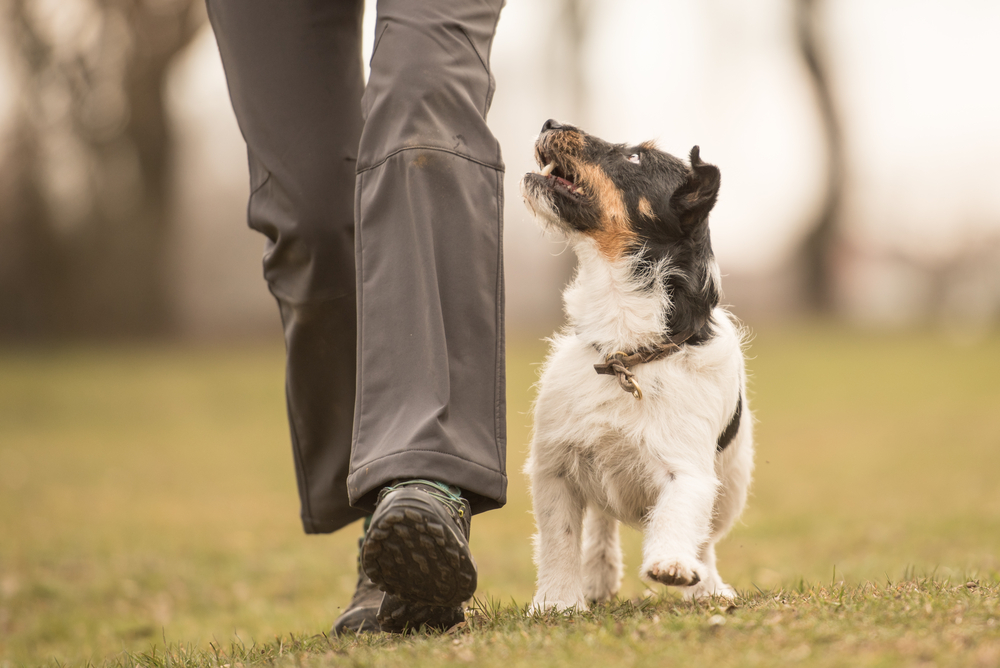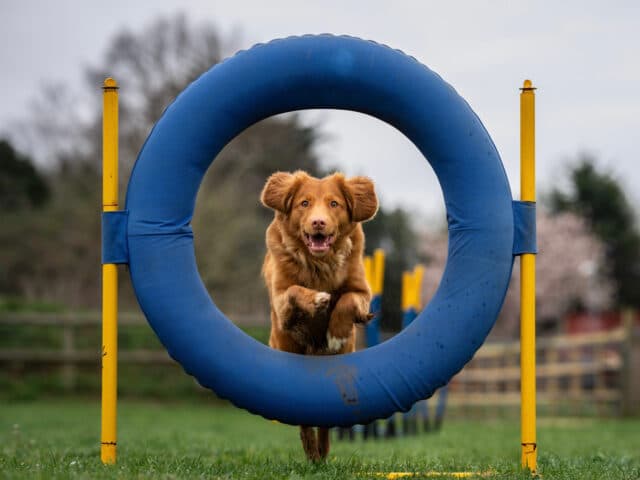Training Your Dog To Be A ‘Good Neighbor’: Addressing Barking, Boundaries, And Social Etiquette
Having a well-behaved dog is essential for maintaining peaceful relationships with your neighbors. Training your dog to be a good neighbor involves teaching them how to manage barking, respect boundaries, and practice proper social etiquette. In this guide, we’ll cover key training techniques to help your dog become a friendly and respectful member of your community.
Historically, dogs have served various societal roles, yet the modern setting demands a nuanced understanding of social etiquette, starting with boundaries. Statistics reveal that 70% of dog behavioral issues stem from lack of proper boundaries. Solutions such as positive reinforcement and engaged walks can transform any household into a beacon of exemplary conduct, benefiting not only the dog but also the community.

Training Your Dog to Be a ‘Good Neighbor’: Addressing Barking, Boundaries, and Social Etiquette
Training your dog to be a good neighbor is essential for harmony in a community. Understanding why your dog barks is the first step. Dogs bark for various reasons: alerting you, seeking attention, or just feeling bored. Be sure to identify the triggers and address them adequately. Consistent commands and rewards can help a lot in reducing unwanted noise.
Setting boundaries for your dog is crucial to prevent unwanted encounters. Clear boundaries ensure that your dog knows where it’s allowed to roam. This can also prevent any territorial disputes with other pets or animals. Use visual markers or barriers to help them understand. Constant reinforcement of these boundaries will make them second nature to your pet.
Social etiquette is equally important in canine training. A well-socialized dog enjoys meeting other dogs and people without causing trouble. Introduce your pet to various environments and situations to build confidence. Dogs that are comfortable in diverse settings are less likely to growl, bark, or shy away. Frequent, positive experiences will help create a socially adept dog.
For effective training, consistency is key. Schedule regular training sessions and stick to them. Reinforce positive behavior with treats, praise, or playtime. Using a mix of verbal cues and hand signals can enhance understanding. A well-trained dog not only makes you proud but ensures a peaceful neighborhood.
How to Address a Neighbor Who Is Complaining About Barking Dogs? : Dog Care Tips
The Significance of Canine Etiquette in Modern Living
Canine etiquette plays a crucial role in our daily lives. As cities grow, more people choose dogs as companions. This increase means dogs interact with strangers and other pets quite often. By teaching them proper manners, we ensure peaceful coexistence. This helps reduce conflicts, making urban living more enjoyable for everyone.
Good behavior in dogs is more than just convenience. It’s about safety for them and those around them. A well-mannered dog knows how to act in various situations. For instance, they know not to jump on strangers or pull their leash. This helps prevent accidents or misunderstandings in busy places.
Dog etiquette extends to shared spaces and public areas. Places like parks and cafes often welcome pets now. But this hospitality depends on pets behaving well. Dogs should follow commands, respecting space and people. A list of basic manners includes:
- Sitting quietly when needed
- Not barking excessively
- Respecting other dogs’ space
Teaching etiquette benefits the dog and the owner. It strengthens the bond between them. Regular training sessions also keep dogs mentally stimulated. This makes them happier and more content. Positive relationships with our pets enrich our modern lifestyle.
Decoding the Canine Language: Why Do Dogs Bark?
Dogs bark for many reasons, and understanding these can strengthen the bond with your pet. Often, they bark to alert their owners of something unusual. This behavior is inherited from their wild ancestors. Sometimes, barking is simply a form of communication or excitement. Recognizing the different types of barks is key to understanding what your dog is trying to say.
One common reason for barking is reaction to stimuli. Dogs may bark when they see a stranger or hear a loud noise nearby. It’s their way of saying, “Hey, there’s something different here!” With training, they can learn to differentiate between real threats and harmless events. This helps manage excessive barking effectively.
Dogs also bark to express emotions. Feelings like loneliness, anxiety, or boredom can all prompt vocal reactions. For example, a dog left alone might bark due to separation anxiety. Providing toys or ensuring timely walks can reduce such behaviors significantly.
Another reason dogs bark is to seek attention or express needs. This can happen if they’re hungry or want to play. By observing their body language, you can often gauge their needs. A table summarizing these reasons may include:
| Reason | Description |
|---|---|
| Alert | Barking at new sights or sounds |
| Emotional | Boredom or anxiety |
| Attention | Requesting interaction |
Teach Your Dog to Respect Boundaries
Teaching a dog to respect boundaries is crucial for safety and harmony. Start by defining clear areas where your dog is allowed. Use physical markers, like fences or baby gates, to help them understand. When outside, a leash can act as a temporary boundary. Remember, consistency is key in ensuring they remember these limits.
Positive reinforcement plays a crucial role in training. Reward your dog with treats and praise when they stay within designated areas. Over time, they’ll associate staying within boundaries with positive outcomes. Avoid negative punishments, as they can cause fear or confusion. Instead, redirect them gently if they cross the line.
Establishing boundaries isn’t just about the physical space. It’s also about social interactions with other pets and people. Teach your dog to respect others’ personal space by practicing commands. Simple cues like “stay” or “leave it” can be effective. Keeping consistent with these commands solidifies respectful behaviors.
Gradual exposure to different environments helps in reinforcing boundary rules. Start at home, then move to more public areas like parks. This helps dogs understand that boundaries apply everywhere, not just indoors. Preparing them for various scenarios will enhance their manners. It also ensures they stay safe in unfamiliar places.
Visual aids can enhance training sessions significantly. Consider using signs or colored tape as a physical reminder of boundaries. Demonstrating these boundaries through playful games makes learning fun. It encourages engagement, making your dog more eager to participate. A sense of accomplishment follows when they successfully adhere to set limits.
Social Etiquette: Training Your Dog for Pleasant Interactions
Training your dog in social etiquette involves teaching them how to behave around others. Like people, dogs need guidance to learn what’s acceptable in various situations. Start with basic commands to establish a foundation. Commands such as “sit” and “stay” can prevent unwanted jumping or running. Repetition and rewards will make these commands a natural response for your dog.
Socialization is a key aspect of etiquette training. Regularly expose your dog to different people, places, and pets. This helps them become familiar with new experiences, reducing anxiety. Arrange meetings with friendly dogs to encourage good behavior. Over time, your dog will learn the dos and don’ts of interaction.
Identifying and managing your dog’s triggers is also vital. Please pay attention to what bothers or excites them too much. If crowds make them anxious, practice calming techniques in quieter settings first. Gradually increase exposure as they become more comfortable. This method builds confidence, making for smoother social interactions.
Using tools like leashes and harnesses ensures control during outings. These tools help guide your dog and prevent stressful situations. Always keep treats handy to reward good behavior immediately. Consistency in training reinforces proper manners over time. This ensures your dog remains a welcome guest in any social setting.
Lastly, establish clear communication with your dog. Use simple hand signals alongside verbal commands for better understanding. Dogs often respond well to visual cues. Practice these techniques daily to reinforce learning. With dedication, your dog will enjoy pleasant experiences wherever you go.
Implementing Consistent Training Techniques for A Harmonious Neighborhood
Consistency in training is the foundation of a harmonious neighborhood. Dogs thrive on routine and regular guidance. Establish a daily schedule for walks, meals, and playtimes. This predictability helps dogs feel secure and well-behaved. Neighbors will appreciate knowing your dog is under control.
Positive reinforcement is an effective method for teaching good behavior. Reward your dog with treats or praise when they follow commands. This encourages them to repeat desirable actions. Avoid harsh punishment, as it can lead to fear or aggression. Instead, redirect negative behavior calmly.
Community engagement can also enhance your dog’s training. Encourage neighbors to interact with your pet in a controlled way. This fosters familiarity and reduces territorial barking. Join community dog walks or playdates to enhance social skills. These activities help create a welcoming environment for everyone.
Training techniques should address common neighborhood concerns. Use commands like “quiet” for excessive barking or “stay” to prevent chasing. Practice these commands in different settings for versatility. Consistent enforcement leads to reliable responses. A well-trained dog contributes to a peaceful neighborhood.
Technology can aid in maintaining training habits. Consider using apps or reminders to keep you on track. They can offer tips and track progress over time. This digital approach ensures regular practice, even on busy days. It keeps both you and your dog motivated.
Finally, patience and perseverance are essential in dog training. Every dog learns at its own pace. Celebrate small successes along the way. Stay committed, and the efforts will pay off. A well-trained dog not only enhances your life but also enriches the community.

Frequently Asked Questions
Wondering how to create a well-behaved pet that fits seamlessly into your community? Here, we address common concerns about training dogs to enhance their social skills and overall conduct. Discover effective strategies for nurturing a canine companion that is both cherished and respected.
1. How can I stop my dog from barking at strangers?
To reduce barking at strangers, begin by understanding the triggers that cause this behavior. Pay attention to when and where your dog barks and if they respond to certain cues. Gradually introduce your dog to new people in a controlled environment, rewarding them for remaining calm and quiet. Consistent exposure along with positive reinforcement when the dog refrains from barking can help build better behavior over time.
Utilize commands like “quiet” or “enough” and immediately reward silence with treats or praise. Over time, your dog will learn to associate strangers with something positive. It’s important to remain patient throughout the process, as changes may take time depending on your dog’s personality and past experiences.
2. What is the best way to set boundaries for my dog?
Establishing boundaries involves both physical and behavioral measures to ensure your dog understands limits. Use physical barriers like fences or baby gates to mark off-limits areas and implement behavioral cues like “stay” or “sit” at boundaries. Training your pet with these commands consistently will build a clear understanding of permitted areas.
Incorporating a structured routine is equally important; this includes designated playtime and exercise. Set clear expectations and follow them diligently to maintain consistency. Over time, your dog will understand and respect the prescribed limits, leading to safer and more harmonious cohabitation.
3. Why is it important for a dog to have social etiquette?
Social etiquette in a dog ensures safe and pleasant interactions with other pets and people. It reduces anxiety and prevents aggressive or unpredictable behavior when they encounter new situations or environments. Well-socialized dogs are typically more relaxed and easier to manage, making them more enjoyable companions.
Being socially adept allows dogs to participate in community activities like dog parks and social gatherings without causing disruption. This not only enhances the experiences for the dogs themselves but also fosters a welcoming and stress-free environment for all involved.
4. Can training enhance my dog’s behavior in public places?
Proper training can greatly enhance a dog’s behavior in public settings by teaching them how to react appropriately. Focus on basic commands such as “heel,” “stay,” and “come” to instill discipline. Consistent practice in various public environments will build their confidence and familiarity.
By repeatedly exposing your dog to different settings, they learn to associate these places with structured behavior. Positive reinforcement of good behavior in public spaces encourages them to act appropriately, which makes outings more pleasurable for both the dog and owner.
5. How do I ensure my dog remains well-behaved around children?
When introducing children to your dog, start with controlled, supervised interactions. Teach your dog to respect a child’s space and to be gentle. Training exercises like “settle” or “gentle” can help your dog understand the nuances of interacting with children safely.
Educate children on how to approach and handle dogs respectfully. Encouraging mutual respect and understanding helps prevent accidents or distressing incidents. With time and practice, both dog and children will share a positive and rewarding bond.
Teach Your Dog ROAD BOUNDARIES
Conclusion
In today’s interconnected world, training your dog to be a good neighbor is an integral part of urban living. It not only fosters peace within the community but also strengthens the bond between you and your pet. By understanding and addressing your dog’s behaviors, you contribute positively to the neighborhood dynamics.
Focusing on consistent training, social etiquette, and boundary setting ensures your dog becomes a model companion. These efforts create a ripple effect, enhancing the overall pet ownership experience within the community. Ultimately, the harmonious presence of well-behaved dogs enriches everyone’s lives.




